Welcome to another exciting installment of Dear Azami! It’s column number 199, and one might even suspect that means there’s something interesting bound to
pop up next week. Who knows!
I mean, I know. And Sean knows. Also, Cedric knows… I’m sure some other people know. But you, loyal reader, you don’t know. So let the anticipation build!
And make sure to come back next week, for reasons completely unrelated to my decision to draw attention to the fact this is column number 199 in Dear
Azami’s lifespan.
Completely. Unrelated.
This week I want to take the opportunity to talk some more about Commander philosophy. No matter what format you’re playing, it’s very important to know
your role. In most one-on-one formats this is fairly easy: ” Who’s the Beatdown?” If you’ve never read that article, it’s
definitely worth your time. It’s one of the fundamental building blocks of Magic theory over the last twenty years, and, like The
Innovator’s analysis of Mulldrifters and Baneslayers
, it’s one of those things that make total sense when you think about it. Whether or not you have time to click-through, though, know that it boils down to
correctly reading the gamestate to know when you should be on offense or defense.
In Commander, it’s easy to miss the subtle cues that help set your role. It’s a multiplayer format, and that’s a significant complication. If one-on-one is
Chess, then a multiplayer game is that ridiculous Tri-Dimensional Chess thing from Star Trek. There are roles in Commander other than the beatdown, and
many of them involve adequately managing your threat.
Threat management relies on understanding the emotional response your actions are generating in your opponents. There is not enough card advantage in the
format for each person to respond to every slight or action, and thus people are forced to prioritize their removal, attacks, and interactions. I’m sure
we’d all like to think the decisions we make in those contexts are purely rational, but we’re human.
Plus, EQ helps you get a better read on your opponents, who will often eschew the most dispassionately rational line of play in favor of the play that
makes the most sense to them. That’s why it’s good to know which of your friends is going to spike the game because they find it funny, and which of your
friends is going to retaliate for any minor slight.
People generate unnecessary threat when they make plays that are more infuriating than powerful. This is one of the reason you don’t tend to see a lot of
Duress effects in Commander; Duress is fairly weak, but it pisses off people to no end when their hand is made public and their best card is taken from it.
That person is probably going to recover from being Duressed, and when they do, they’re going to be irked at you.
Similarly, when I was talking to one of my friends, he asked me why I tend to build with redundancy over protection. The reason is threat abatement. If you
let your opponents blow up your threatening permanents now and again, they’ll be more likely to direct their efforts elsewhere while you rebuild. If you
protect your threats, either with removal, counterspells, or hexproof, your opponents are going to be frustrated, and they’ll intensify their assault on
your position.
Give your opponents false victories, and they might confuse them for real ones.
With that in mind, let’s look at this week’s letter, which discusses a commander for whom I have a particular fondness. I think it pairs well with last week’s take on Phelddagrif. Take it away, Andre!
|
Dear Azami,
Hello! I’ve been into Commander for a year now, and since i started brewing my first deck (a Commander 2013 Oloro deck that later became a Sydri combo
Also, for budget, I have none since i would like to see the optimal deck build and buy the necessary cards a little bit at a time (except for dual lands, 7 Island 5 Mountain 9 Plains |
Many people look at Zedruu the Greathearted and see a Group Hugs commander. Those people are not wrong, but they do fail to grasp the real power of Zedruu.
She’s amazing not because she’s friendly, but because she’s the commander best positioned to control the flow of the game. See, Zedruu is the premier
kingmaker, and that role is a ton of fun.
Andre’s deck falls into a relatively common Zedruu trap: focusing on locks, which generate a ton of threat. When you get locked out of doing something
important in Commander, the universal solvent is killing the player who is locking you down. Considering how infuriating it is to be locked out of a game,
that universal solvent often becomes the first choice in those situations, even if there’s another way out of the bind. Locking a person down doesn’t
actually kill that person, after all. It’s powerful, but not inherently fatal.
And, as Andre has described, playgroups have memories. If your lockdowns are difficult to deal with once they’ve ensnared someone, people are going to kill
you before you can trap them. When you’re shouldering that level of preemptive threat, abatement becomes all the more important.
Luckily, kingmaking can be a powerful threat abatement system on its own. Let’s see how that looks in my build:
The Land Section
Out
(1):


In
(2):
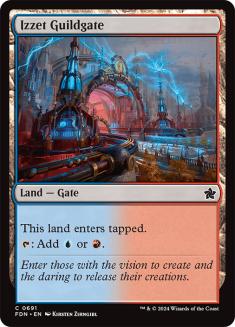
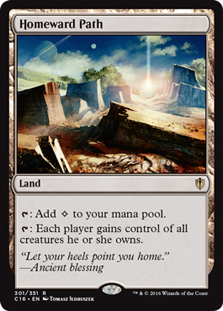

I counted a couple of times because it can be easy to get the count wrong, but I think the deck Andre submitted was short a land. It came to 98 cards, 37
of which were lands, and it only had two of the three guildgates for the Jeskai colors. As such, I assume that the absence of Izzet Guildgate is just a
clerical error, although I think it’s worth putting in there if it’s not. Zedruu is the type of deck that really wants to be running 38 lands plus several
mana rocks, because sometimes you need to give away a land for value without interfering with your own mana production abilities.
In general, I feel like the land section is the least useful part of my Dear Azami columns. If you have more money, or a larger collection, you can
basically upgrade any manabase on your own. Just pick a cycle of dual lands you’re missing, and then cut the weakest lands in favor of them. The hardest
part is maintaining enough basics, particularly when you’re running cards like Oath of Lieges, but most decks can run almost perfectly well off a budget
manabase. So long as you realize that playing original duals in Commander makes you a target, you should be able to find your own personal balance.
Side note: Does Oath of Lieges work like I think it does? Because if you can donate it to an opponent and still get value off it, that seems awesome.
The one land that I do think is worth adding, though, is Homeward Path. Every once in a while it’s going to be beneficial for you to reset creatures back
to their proper owners. Homeward Path lets you do that at least once a turn cycle, if necessary. It’s also particularly strong with Perplexing Chimera,
which is one of the better Zedruu the Greathearted cards.
The Switch-Up Section
Out
(10):
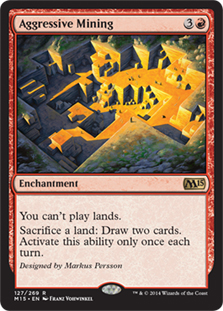
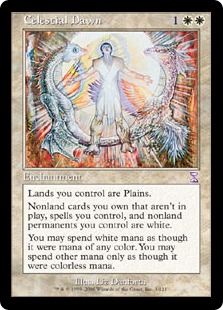
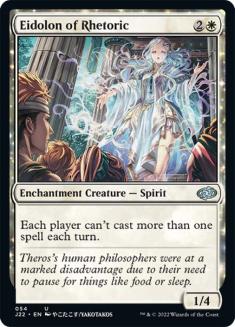
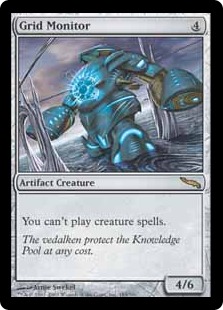
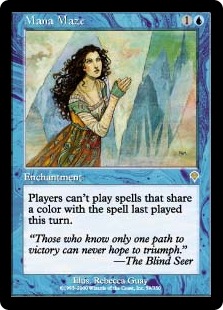
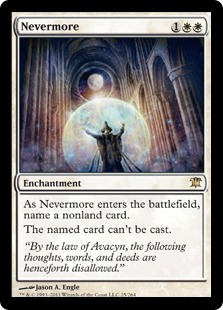
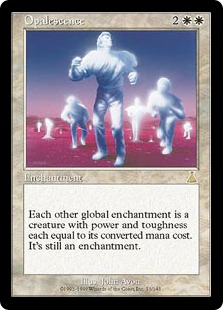
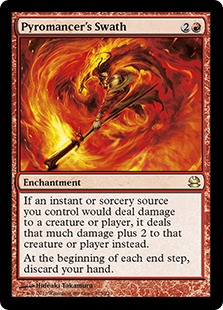
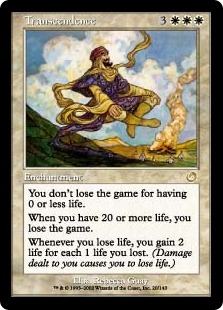
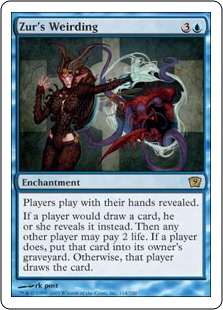

In
(5):
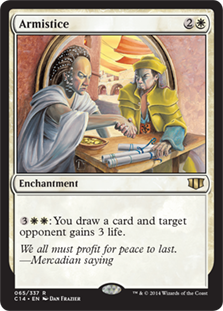
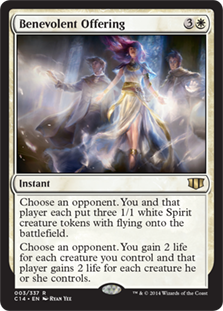
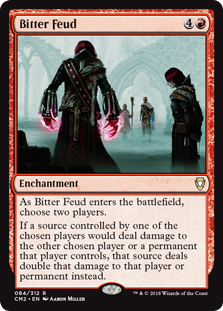
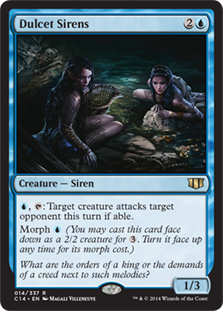
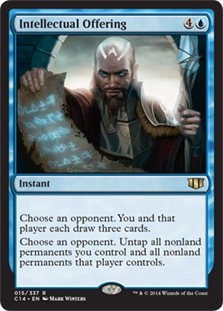

The major change I made to this deck involved ripping out the locks and replacing them with cards that help you shape the direction of the game. Zedruu, in
my opinion, is at her most entertaining when you sit back behind some defenses and direct the flow of the game. It’s the Weeping Willow strategy;
lockdowns, by their very nature, are inflexible. You are preventing a person from doing X. Sometimes they’ll be able to get around this proscription by
doing Y, and then your lock has broken.
I’d rather tell an opponent, “look, you can attack me, but if you do so it’s going to cost you a ton of resources, and you can attack our mutual opponent
for free. Heck, I’ll help you!” If they hear that and still spend all their resources to attack you, you haven’t had a lock broken in the same way; with
the lifegain from Zedruu you can probably survive a couple of hits, and then you can speak with the mutual opponent and help that person attack the one who
spent all their resources scraping your knee.
That type of politicking draws less aggro than the locks. Like, Aggressive Mining is a mean card! That’s going to draw a lot of hate, and it comes tied to
a draw engine that will help your opponent draw into something to ruin your day. Celestial Dawn makes nonwhite decks unable to cast any nonartifact spells,
but it does very little against any decks with white in their color identity. If you play that, people are going to assume the worse and flare up against
you.
If I wanted to play an effect that says “your opponents can only cast one spell per turn,” I’d probably play Rule of Law or Arcane Laboratory over Eidolon
of Rhetoric. A 1/4 body is relevant in Commander, but I still think you’d want the effect to be able to survive Wrath of God. Grid Monitor locks people out
of playing creatures, but it is also a risky card to play since Zedruu the Greathearted needs to be on the board when you cast the Grid Monitor, and if
they snipe her while the Monitor is on the stack, you’re up a creek with no paddle.
Mana Maze strikes me as being about as much fun to play against as Spreading Plague. Cards like that will randomly screw someone out of a game, and it’s no
fun having to wait a full turn cycle only to find out you can’t make any of the plays you had hoped would get you out of your hole.
False hope can be embittering.
Nevermore is not what you want either because the primary reason to run it in Commander is to name a commander, and that’s just mean. As the recent changes
to the tuck rule have reminded us all, commanders are the key element that distinguishes Commander from most other formats, and preventing a person from
using theirs can just lead to unpleasant play experiences.
Opalescence may have utility outside of Enchanted Evening combo locks, but as a rule I try to avoid cards that make your enchantments and artifacts
significantly more fragile. Who would want Day of Judgment to wipe their noncreature spells as well? Not me!
Pyromancer’s Swath is basically a discard lock. Again, this makes a person very angry with you while leaving that person in a position where they can still
topdeck something to make you equally miserable. Plus, if they kill Zedruu in response to you casting it, you may end up having to dump your hand, and that
sucks. A lot.
Transcendence is basically just a combo kill with Zedruu, so long as Zedruu survives for long enough for you to give it away. That’s boring! Finally, Zur’s
Weirding is the type of card that can just grind a game to a halt. With 40 life per player, you don’t want to create a situation where no one draws cards
for ten turns. Zur’s Weirding is really good at that one, so I cut it.
In its place I put in the type of card that you can use to push another player into doing what you want them to do. A lot of these cards trace back to the
Commander precons because those decks promoted a lot of interesting multiplayer dynamics. For example, Dulcet Sirens is the Nettling Imp that you’d want in
multiplayer. Just remember, if you’re trying to get something to swing into a player with a Propaganda effect on the table, they can just choose not to pay
the cost, thus blanking the forced attack.
But the Offering cycle is another example of that neat multiplayerism the Commander precon designers have promoted. While the Benevolent Offering is
probably not going to net you as much life as it’ll net your opponent, it’s a great way to try to save someone else who is faltering. Generally the way to
win a game you’ve been kingmaking is to make sure the other person who makes it to the endgame with you is already bleeding. Sometimes this means saving a
weaker player because together you can take out the stronger player, leaving you staring down someone who needed your help to survive. Benevolent Offering
helps with that. So does Intellectual Offering, which can also be used to turn an opponent’s alpha strike into a Pyrrhic victory.
Side note: how is there a Pyrrhic Revival in a multiverse that doesn’t have a King Pyrrhus? Or
are we living on whatever plane gave us Arabian Nights and Legends?
Armistice is a pricey draw engine, but mediocre draw engines are still draw engines, and occasionally you’ll want to be giving your opponents the life. But
Bitter Feud is a particularly good card in this type of deck since not only does it channel two people at each other (when those targets are carefully
chosen), it can be pointed at two players and then donated to a third, where it will stay drawing you cards off Zedruu triggers even after one (or both) of
the feuding players have left the game.
The Jujitsu Section
Out
(4):
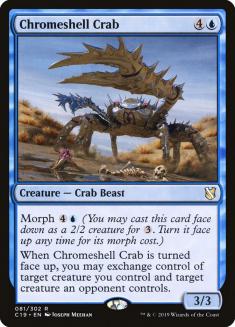
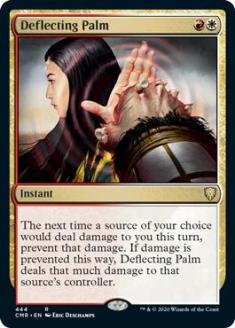
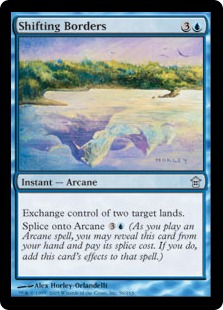
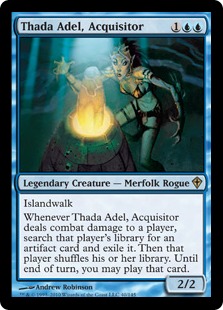

In
(4):

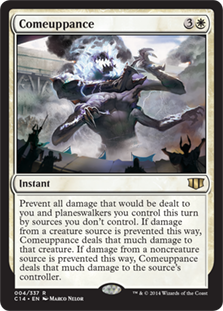
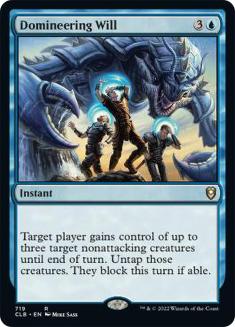
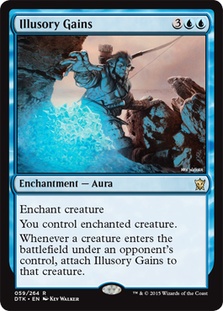

I think jujitsu decks make for the most entertaining type of control decks in Commander. Not only is there some wicked satisfaction in throwing a person’s
Baneslayer Angel back in their face, but it’s also a good way to power match. Even Bribery, which is a brutal card I hope to see reprinted in Modern
Masters 2, can only get the most powerful card in a player’s deck.
Deflecting Palm isn’t a particularly good variety of jujitsu in Commander. Damage to the face is pretty weak since you start with so much life that any
individual creature is unlikely to do a major dent in your total. Something like Comeuppance is a better variety of the effect, both because it’s not
limited to a single damage target and because it can take out creatures.
Chromeshell Crab is way too expensive for its ability. If you want that ability and are willing to spend $20 on it in the real world, compare it to Gilded
Drake. While a more reasonably priced version of this effect (in every way) can be found on Shifting Loyalties or Switcheroo, eight mana is a lot to spend,
particularly in that specific combination of costs. Like, perhaps it would be worth keeping if it also had the ability as an enters-the-battlefield effect,
like Ponyback Brigade does, but you have to cast it as a morph and then pay a nigh-impossible-to-reduce five mana. It’s a lot of work, particularly when
you can get a reuseable version of this effect for ten mana via Avarice Totem.
Of course, I don’t advise adding Avarice Totem. It draws far more aggro than its casting cost would suggest. Similarly, I would avoid Shifting Borders.
People get touchy when you mess with their manabases, and there aren’t a lot of situations where you’re going to be glad to draw that card from the top of
your deck.
Thada Adel, Acquisitor is a good card, but it needs to connect to gain its advantage, and without a card to ensure islandwalk, like Stormtide Leviathan,
I’d often rather play Acquire. In this deck, I’d rather play neither. People get touchy when you steal permanents from their deck.
Instead, let’s steal them from the board! Catch // Release is a solid card whether you’re using either side of the card or going for the full on fusion. If
you can fuse the card, it lets you sacrifice the stolen permanent, but even Catch is a solid roleplayer as an unrestricted Act of Treason. And Release is
basically a super edict that offers a means of dealing with many difficult permanents in one fell swoop.
Domineering Will is another way to keep people alive, but it’s also solid removal for troublesome creatures. See, the person you’re giving the creatures
to, or the person who suddenly is facing down blockers, may find their interest runs with yours. If so, they’ll jump at the opportunity you’re creating,
engendering goodwill at the same time you deal with some annoying creatures on the board.
Finally, there’s Illusory Gains. I think I know how this card works in Commander, but I could be wrong. Basically, control of a permanent is determined by
the most recent effect that changes its ownership. When I played Worldwake Two-Headed Giant with my partner, she used this to permanently give me the
creature she had stolen with whatever Treachery effect was in that set, thanks to the ever-useful Bazaar Trader. At the cleanup step our opponents expected
Mark of Mutiny to give their creature back, but since Dana no longer owned it, I kept the creature.
What this means with Illusory Gains, I think, is that you can use the card to basically shuffle new-to-the-battlefield creatures across the board for as
long as Illusory Gains is in play. You give away whatever the most recent creature was, and then when the next creature comes into play Illusory Gains
steals it for you. Since the card that Illusory Gains is departing is not currently being governed by the “you control enchanted creature” clause, it
doesn’t go back to its owner when Illusory Gains moves. I think. If not, scratch that idea. It just seems like a fun way to control the flow of the game.
Incidentally, I once played against a Norin the Wary/Confusion in the Ranks Commander deck. It was miserable to play against, but I imagine the pilot was
having a ton of fun.
The Defense Section
Out
(3):
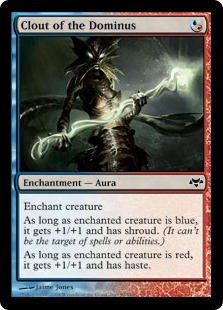
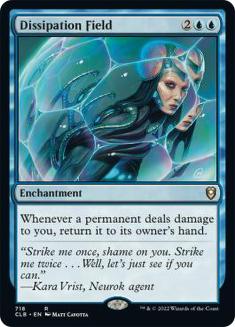
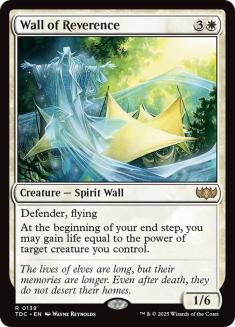

In
(8):
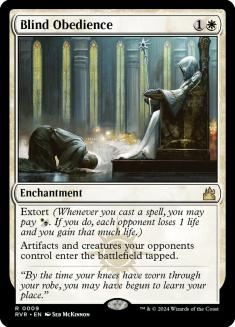
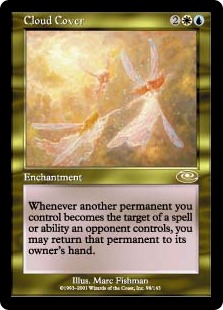
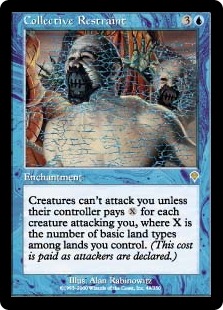
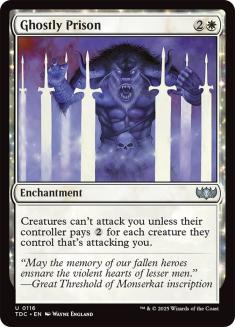
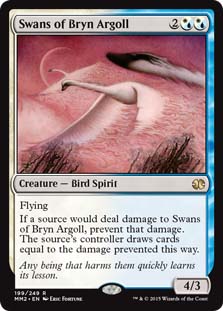
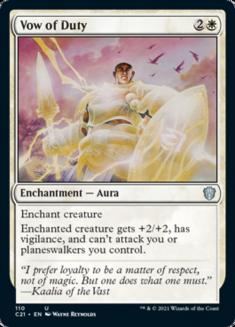
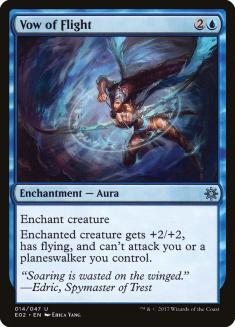
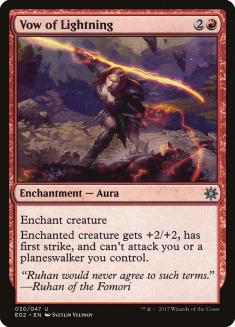

As I mentioned earlier, I’d much rather have action than protection. That’s why I generally cut Clout of the Dominus whenever I see it. I’d usually rather
play Lightning Greaves if I want shroud since that also gives haste, can be shuffled around, and works no matter what the color of the attached creature.
When you’re playing cards like Sun Titan that you might want to protect, Clout of the Dominus can let you down. But again, since Zedruu the Greathearted
doesn’t have a tap effect and only costs four mana, I think you can do without the protection.
Dissipation Field was cute, but I didn’t really get it. It seemed like it might be included to use as an Aetherize to donate it to someone who’s being
hammered? Aetherize is a fun card in decks like these, so I guess that could work. Still, I’d rather run something like Cloud Cover. Cloud Cover is good
because it doesn’t mess with your ability to donate with Zedruu’s targeted ability, but it blanks all sorts of spot removal your opponents use. Plus, there
are going to be times where getting the card back to your hand is going to be better than it surviving out on the board, especially if you’ve been
sandbagging a Rout or End Hostilities.
Wall of Reverence is a wall that gains you life. It is good at both of those things in the right deck… but this is not that deck. The deck has relatively
few creatures in it, and many of the ones that are being played aren’t exactly known for their power. As a result, you’re not going to be gaining enough
life off this card for it to be worth the slot. It’s a good blocker, but not a great one, since there are plenty of cards in Commander with six or more
power. A better blocker looks like Swans of Bryn Argoll. Impossible to kill with damage or deathtouch, it has a bit of the group hugs feel while being a
deceptively powerful creature underneath it all. It can still do damage, unlike cards like Fog Bank that can’t do damage no matter how powerful it becomes.
Often, that means you can eat what you can’t blank. It’s slightly more vulnerable to trample, but it can survive being trampled more than once, which makes
up for that weakness a bit.
Blind Obedience is in the mix for two reasons: It cuts off haste, and it gains you a fair amount of life over the course of a game without drawing a
proportionate amount of aggro. So long as you’re only triggering extort once per spell, people tend to be fairly forgiving of losing a single life or
taking a single point of damage. Especially when it’s not an unceasing cinch, like Underworld Dreams. Extort only triggers when you want it to trigger,
which means there will be plenty of spells that aren’t pinging your opponents. It doesn’t have the same sort of finality to it, and that works in your
favor.
If you fall out of favor, though, it helps to be difficult to attack in mass. This is why I like Propaganda effects. Since they’re cumulative, it’s not
hard to create a situation where they mathematically can’t attack you with enough creatures to make it past your defenders. Up until that point, by forcing
your opponents to use some of their limited resources against you, you end up dodging a lot of the attacks of opportunity that can screw over a player
during the build up. That’s why I added two more. Ghostly Prison is a solid one, being just a colorshifted reprint of Propaganda, but I’m particularly fond
of Collective Restraint. It’s easy to overlook since it’s a domain card, and domain doesn’t tend to scale well outside of rainbow decks, but even in a
two-color deck it’s still a slightly costlier Propaganda redundancy. In a wedge deck like this one, it’s often going to be taxing your opponents’ attacks
against you for three mana a pop… even if it has the potential to be a zero mana cost if you’re stuck on all nonbasics. But! With all those basic lands,
you should be fine!
Finally, there are the vows. Vow of Duty and friends are moderately powerful in a normal deck, although they’re not my first choice to manage the board.
They shine behind a Zedruu Pillow Fort deck, however. Normally, if you give an opponent possession of a vow, the creature’s controller is free to turn
around and start attacking you instead. When you’re behind Sphere of Safety effects, the creature’s controller might very well not want to pay to attack
you, putting them in a position where they end up attacking the person you want. Sure, most of the time you’re going to want to retain control of the vow,
but in this type of deck you get an extra mode, and that’s super cool.
The Removal Section
Out
(4):

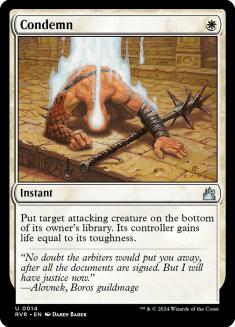
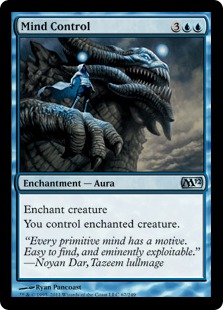
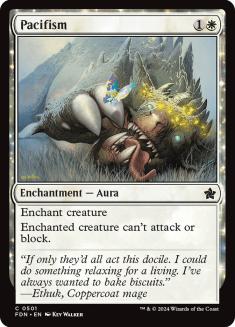

In
(5):
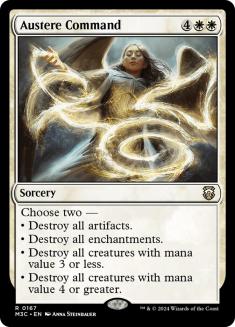
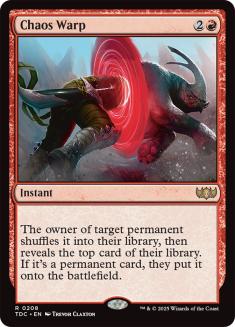
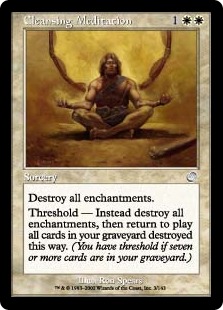
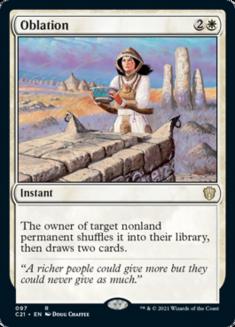
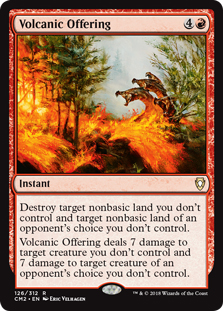

I don’t love Arrest and Pacifism in Commander. If I have to run one, I tend to fall more towards Prison Term or Faith’s Fetters. And Oblivion Ring and
Banishing Light are clearly great in a deck like this, where you get the same ability to trade it away for value without the vulnerability to protection or
bounce.
I cut Condemn because it’s less reliable than Swords to Plowshares, especially after the change in the tuck rules. In general, I tend to lean more towards
Chaos Warp and Oblation since they lack restrictions and offer more upside, which means less aggro. You lose out on the card potential offered by aura
removal, but I think that’s okay now and again.
Plus, occasionally you can point Chaos Warp or Oblation at something of your own that’s about to be otherwise eliminated, although that’s more of a play of
desperation than sound strategy.
Mind Control was replaced by Illusory Gains, but Illusory Gains isn’t reliable enough to consider it removal, thus the classification shift. Instead, I
added in Austere Command, Cleansing Meditation, and Volcanic Offering. Austere Command is the selective sweeper, and it’s been slowly creeping up in price
over the years due to its Commander versatility. If you had to ask me what’s the one white card I’m most likely to play in Commander, it would certainly be
Austere Command. Being able to choose two modes is huge, and it’s what makes it feel worlds better than Merciless Eviction, which is otherwise a slightly
more versatile card.
Cleansing Meditation is the Tranquility for enchantment decks, and particularly in the wake of Theros, that’s important. Finally, Volcanic
Offering completes the offering cycle mentioned above, only it does it with a bang! Two dead creatures and two dead nonbasic lands. If you’re worried about
the aggro and think they’ll make the smart decision, you can even give the player whose land or creature you’ve blown up the option to choose the other two
targets, which might go some way towards ameliorating their hurt feelings.
The Draw Section
Out
(1):
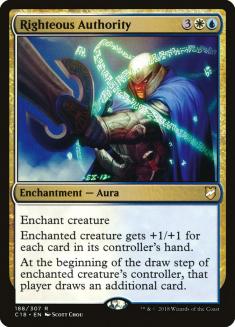

In
(3):
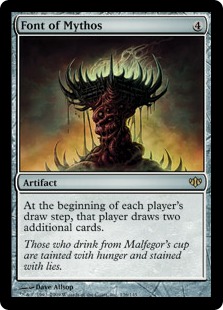
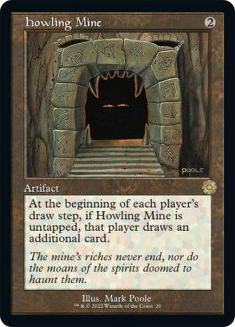
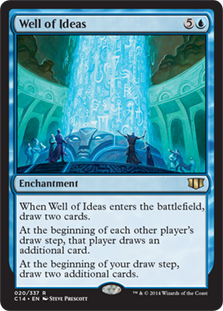

I’m usually pretty sanguine about letting my opponents draw cards. If everyone’s draws are turbocharged, someone is going to have the cards to hammer down
the nails that jut out from the rest. Let the others claw themselves to pieces with their spoils; no one has the mana to respond to everything and
everyone. Even if they have the best cards in their decks, they’re going to have to make choices.
You can influence their choices.
Anyway, I took out Righteous Authority because, despite it being something that can be readily given away due to the wording of the draw clause, it’s
vulnerable to creature removal. A turn later you can get Well of Ideas, which will not only keep drawing you a card a turn more than it gives your
opponents but that also draws you two cards as soon as it comes into play. That’s the type of immediate benefit that Righteous Authority can’t grant you.
The Finisher Section
Out
(5):
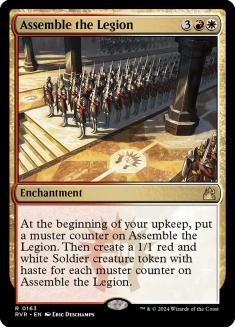
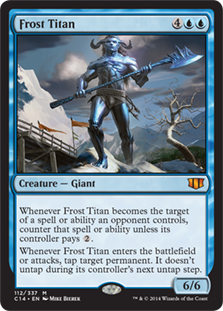
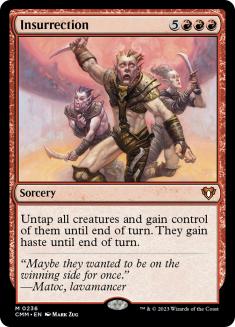
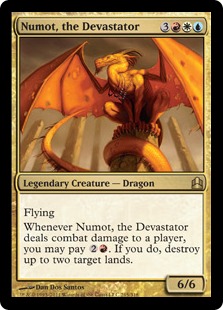
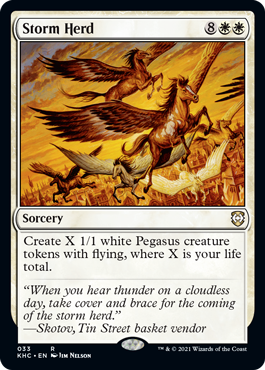

In
(2):
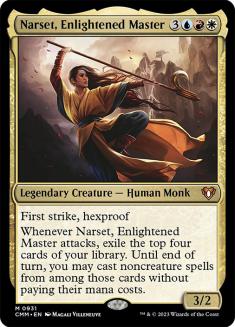

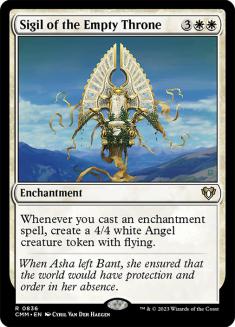

When you’re struggling to kill a locked player before they can draw themselves out of their situation, it makes sense to want to run a bunch of finishers.
But when you’re setting your opponents to fight amongst themselves, you can usually bury them under card advantage.
A card like Assemble the Legion is strong, but it also proclaims its inevitability. It’s an obvious threat that gives your opponents a couple of turn
cycles before they reasonably have to deal with it. It draws aggro without setting you up to deal with it. A card like Sigil of the Empty Throne, on the
other hand, can give you advantage the turn you play it, and it leaves a relevant presence on the board even if it’s killed within the turn cycle. A 4/4
Angel for five mana is reasonable at five mana, even if it’s not a great rate. A 1/1 Soldier for five mana is not.
Frost Titan has been outclassed in recent years. The “targeting tax” matters less in big-mana Commander, and the 6/6 body without evasion isn’t ideal
either. If you really want a repeatable ice breath effect in Jeskai colors, you have the option of running Ojutai, Soul of Winter and/or Rimescale Dragon
(if you upgrade to snow lands). For one mana more they both come with evasion, and Ojutai even comes with vigilance and Dragon empathy on top of the ice.
All the same, they’re a little too Baneslayer Angel for my tastes.
I do think it’s usually worth playing a second commander in your list, in case you ever feel like shaking things up. Numot, the Destroyer is a red flag in
those colors since its draconic power is to grief an opponent’s manabase. Instead, this deck might be able to take Narset, Enlightened Master out for a
spin from time to time. It’s not ideal, but with twelve creatures you’re almost sure to hit a relevant spell with each swing.
I mean, you’re not really going to ever play the deck without Zedruu the Greathearted, I know, but Narset is a fun Baneslayer, and this deck has just
enough spells to support her.
Finally, I cut Storm Herd because it’s variable and ten mana. By the time you make it to ten mana you’re not going to be at a reliable amount of life, and
even if you are, it just seems like spitting out twenty-some Pegasi is going to be a boring way to win the game. It’s like Insurrection: a one-card combo
that should win you the game when it resolves, even if it’s not always guaranteed to. I don’t like those types of cards, because either the game ends then
and there or the rest of the board teams up on you to kill you.
Either way, that seems like the end of a potentially enjoyable play experience.
Creatures (14)
- 1 Windborn Muse
- 1 Fog Bank
- 1 Swans of Bryn Argoll
- 1 Gwafa Hazid, Profiteer
- 1 Bazaar Trader
- 1 Kazuul, Tyrant of the Cliffs
- 1 Sun Titan
- 1 Zedruu the Greathearted
- 1 Drogskol Reaver
- 1 Akroan Horse
- 1 Perplexing Chimera
- 1 Narset, Enlightened Master
- 1 Dulcet Sirens
- 1 Humble Defector
Lands (38)
- 8 Plains
- 5 Mountain
- 7 Island
- 1 Temple of the False God
- 1 Secluded Steppe
- 1 Lonely Sandbar
- 1 Forgotten Cave
- 1 Terramorphic Expanse
- 1 Reliquary Tower
- 1 Rupture Spire
- 1 Evolving Wilds
- 1 Command Tower
- 1 Homeward Path
- 1 Transguild Promenade
- 1 Izzet Guildgate
- 1 Azorius Guildgate
- 1 Boros Guildgate
- 1 Mystic Monastery
- 1 Wind-Scarred Crag
- 1 Tranquil Cove
- 1 Swiftwater Cliffs
Spells (48)
- 1 Ghostly Prison
- 1 Propaganda
- 1 Howling Mine
- 1 Meekstone
- 1 Collective Restraint
- 1 Righteous Cause
- 1 Oblation
- 1 Oath of Lieges
- 1 Statecraft
- 1 Armistice
- 1 Cloud Cover
- 1 Rout
- 1 Cleansing Meditation
- 1 Boros Signet
- 1 Izzet Signet
- 1 Azorius Signet
- 1 Austere Command
- 1 Oblivion Ring
- 1 Wild Ricochet
- 1 Prison Term
- 1 Gather Specimens
- 1 Sigil of the Empty Throne
- 1 Font of Mythos
- 1 Temple Bell
- 1 Norn's Annex
- 1 Chaos Warp
- 1 Vow of Duty
- 1 Vow of Flight
- 1 Vow of Lightning
- 1 Mind Unbound
- 1 Sphere of Safety
- 1 Blind Obedience
- 1 Wear
- 1 Catch
- 1 Curse of the Swine
- 1 Darksteel Mutation
- 1 Dictate of Kruphix
- 1 Banishing Light
- 1 End Hostilities
- 1 Jeskai Banner
- 1 Bitter Feud
- 1 Benevolent Offering
- 1 Intellectual Offering
- 1 Comeuppance
- 1 Domineering Will
- 1 Volcanic Offering
- 1 Well of Ideas
- 1 Illusory Gains

I like the curve on this version. It peaks at three mana, before giving you a bunch of fours, fives, and sixes to keep you in action as the game goes on.
Here, take a look:
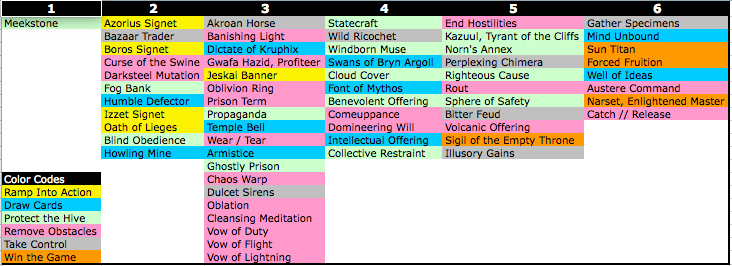
It’s not as focused on the poisoned apple as your build was, but instead it gives you the opportunity to nudge and shove people into doing what you want
them to do. Often, this is going to be through using your donation powers to give pikes to defending armies, while other times it will be enough to sit
behind your castle walls and put a thumb on the scale here and there while your opponents use up all their best cards on one another.
Either way, it’s fun, and remember… every choice a person makes is a chance to influence that person. Use this power wisely.
|
CARD |
PRICE |
|
0.25 |
|
|
0.25 |
|
|
0.25 |
|
|
0.25 |
|
|
0.29 |
|
|
0.29 |
|
|
0.29 |
|
|
0.49 |
|
|
0.49 |
|
|
0.49 |
|
|
0.49 |
|
|
0.49 |
|
|
0.49 |
|
|
0.49 |
|
|
0.59 |
|
|
0.75 |
|
|
0.79 |
|
|
1.09 |
|
|
1.49 |
|
|
1.85 |
|
|
2.59 |
|
|
2.99 |
|
|
3.45 |
|
|
3.79 |
|
|
5.50 |
|
|
5.75 |
|
|
7.05 |
|
|
7.19 |
|
|
TOTAL |
50.17 |
The total came to a reasonable $50 and change. I wasn’t particularly keeping to a budget for this build, but I find a lot of the cards I find enjoyable to
play are relatively cheap because they’re not obviously powerful. Like Austere Command, many of these cards will creep up year after year as people
discover them; but some will stay cheap forever, and that’s okay too.
Thanks for the trip, Andre! I do love me some Zedruu the Greathearted, and I’m glad to offer a bit of a differing perspective on the Pillow Fort archetype.
It wasn’t my intent when I started the article, but it evolved in that direction, and I think there’s room for difference of opinion on the subject.
That concludes this week’s build; if you’re interested in having us choose your deck for Dear Azami, just email us at DearAzami [at] gmail [dot] com. The
lucky chosen winner will receive $20 in store credit to StarCityGames.com, as well as bragging rights among the small circle of people who think that kind
of thing is cool. I’m a proud member of that circle, and you could be too!
And tune in next week for completely innocent reasons that have nothing to do with this being column number 199 in Dear Azami’s history. There’s no chance
at all that we’re doing something special next week. Who celebrates milestones?
Want to submit a deck for consideration to Dear Azami? We’re always accepting deck submissions to consider for use in a future article. Only one deck
submission will be chosen per article, but being selected for the next edition of Dear Azami includes not just deck advice but also a $20 coupon to
StarCityGames.com!
Email us a deck submission using this link here!
Like what you’ve seen? Feel free to explore more of Dear Azami here, in the Article Archives!
And feel free to check Jess’s own Command of Etiquette
column on Hipsters of the Coast, for more Commander and casual content. Now on Thursdays!
